Business Law
VerifiedAdded on 2023/06/12
|9
|1867
|451
AI Summary
This article discusses the principles of contract law, promissory estoppels, and restraint of trade clause in business law. It provides answers to case studies and examples. The article covers the topics of intention to create a legal obligation, the doctrine of promissory estoppels, and the validity of restraint of trade clause.
Contribute Materials
Your contribution can guide someone’s learning journey. Share your
documents today.
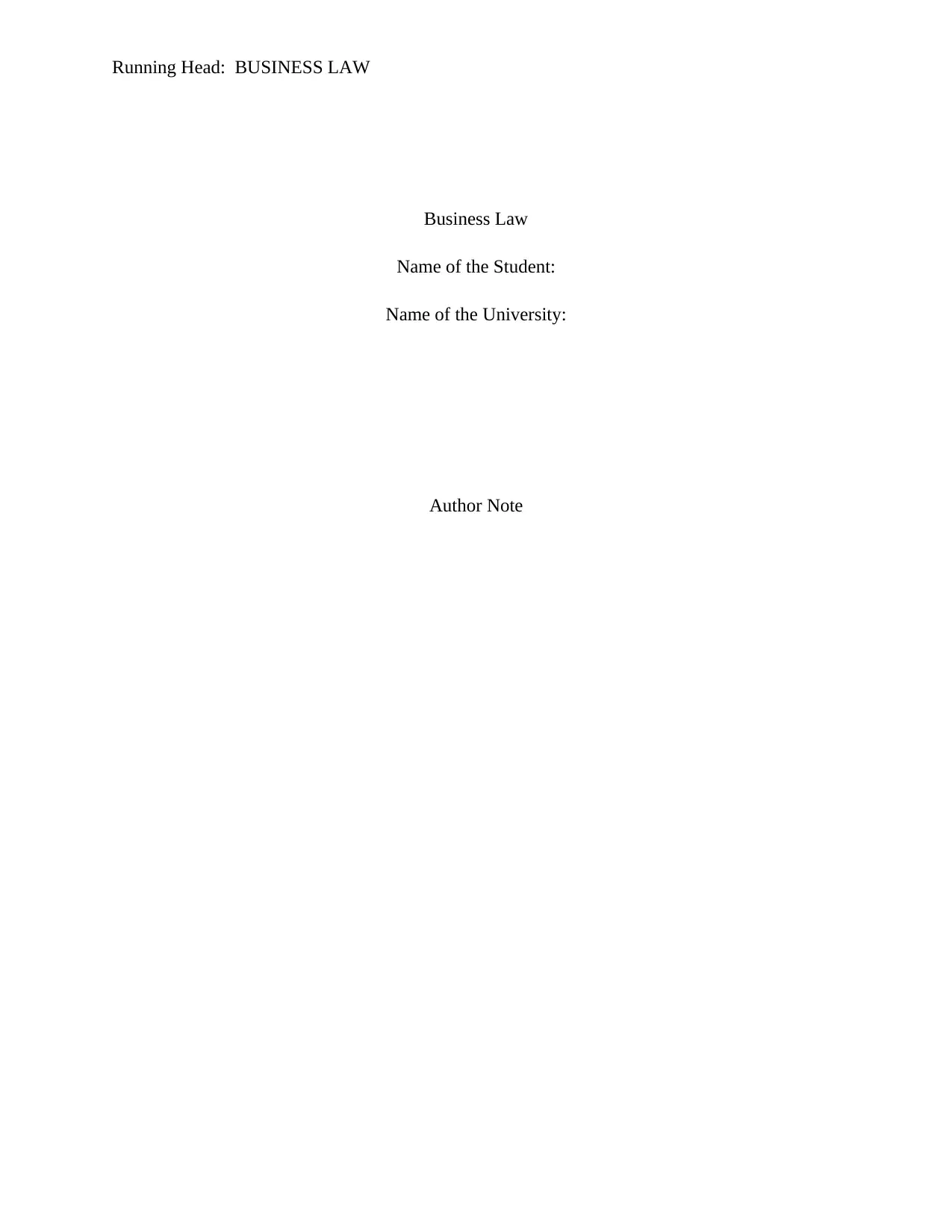
Running Head: BUSINESS LAW
Business Law
Name of the Student:
Name of the University:
Author Note
Business Law
Name of the Student:
Name of the University:
Author Note
Secure Best Marks with AI Grader
Need help grading? Try our AI Grader for instant feedback on your assignments.
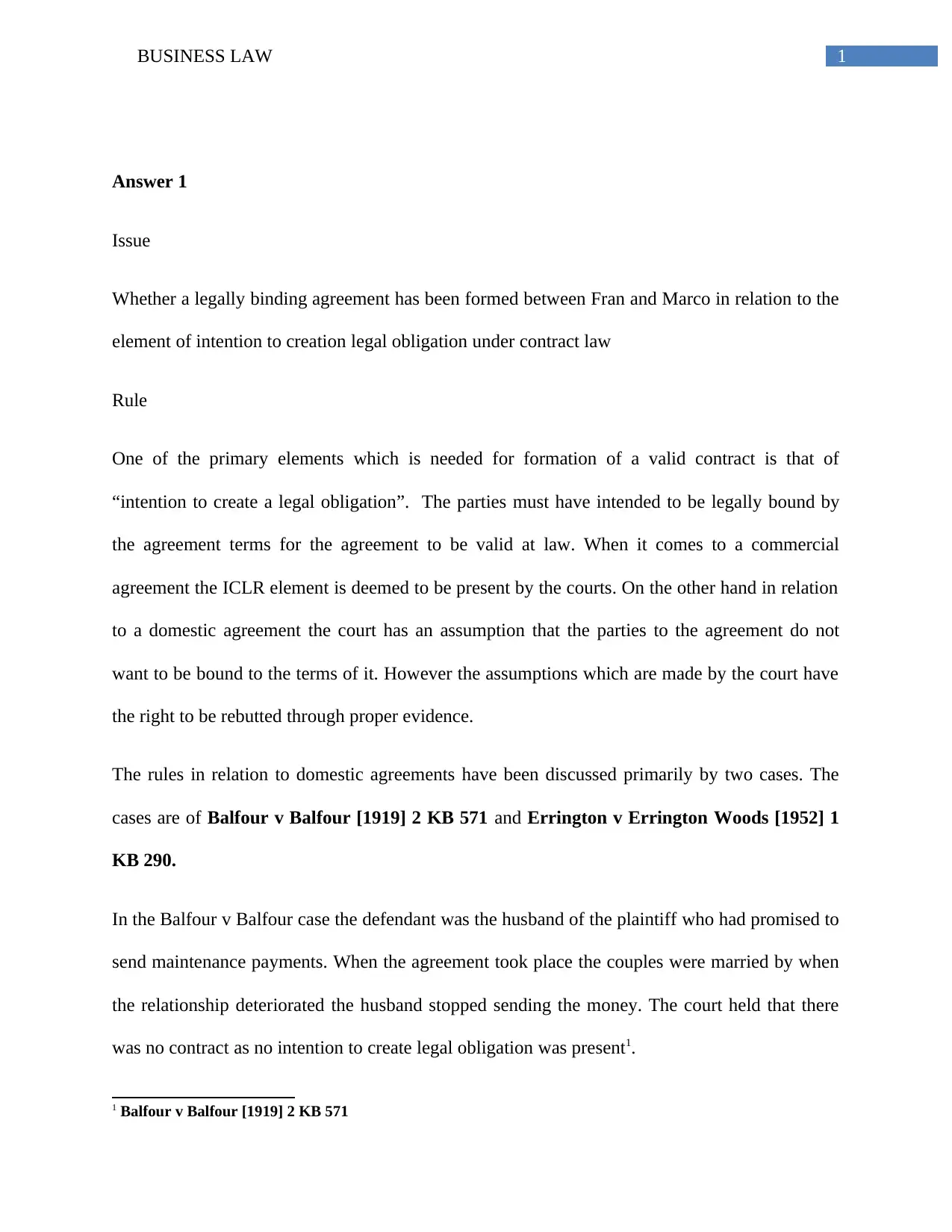
1BUSINESS LAW
Answer 1
Issue
Whether a legally binding agreement has been formed between Fran and Marco in relation to the
element of intention to creation legal obligation under contract law
Rule
One of the primary elements which is needed for formation of a valid contract is that of
“intention to create a legal obligation”. The parties must have intended to be legally bound by
the agreement terms for the agreement to be valid at law. When it comes to a commercial
agreement the ICLR element is deemed to be present by the courts. On the other hand in relation
to a domestic agreement the court has an assumption that the parties to the agreement do not
want to be bound to the terms of it. However the assumptions which are made by the court have
the right to be rebutted through proper evidence.
The rules in relation to domestic agreements have been discussed primarily by two cases. The
cases are of Balfour v Balfour [1919] 2 KB 571 and Errington v Errington Woods [1952] 1
KB 290.
In the Balfour v Balfour case the defendant was the husband of the plaintiff who had promised to
send maintenance payments. When the agreement took place the couples were married by when
the relationship deteriorated the husband stopped sending the money. The court held that there
was no contract as no intention to create legal obligation was present1.
1 Balfour v Balfour [1919] 2 KB 571
Answer 1
Issue
Whether a legally binding agreement has been formed between Fran and Marco in relation to the
element of intention to creation legal obligation under contract law
Rule
One of the primary elements which is needed for formation of a valid contract is that of
“intention to create a legal obligation”. The parties must have intended to be legally bound by
the agreement terms for the agreement to be valid at law. When it comes to a commercial
agreement the ICLR element is deemed to be present by the courts. On the other hand in relation
to a domestic agreement the court has an assumption that the parties to the agreement do not
want to be bound to the terms of it. However the assumptions which are made by the court have
the right to be rebutted through proper evidence.
The rules in relation to domestic agreements have been discussed primarily by two cases. The
cases are of Balfour v Balfour [1919] 2 KB 571 and Errington v Errington Woods [1952] 1
KB 290.
In the Balfour v Balfour case the defendant was the husband of the plaintiff who had promised to
send maintenance payments. When the agreement took place the couples were married by when
the relationship deteriorated the husband stopped sending the money. The court held that there
was no contract as no intention to create legal obligation was present1.
1 Balfour v Balfour [1919] 2 KB 571
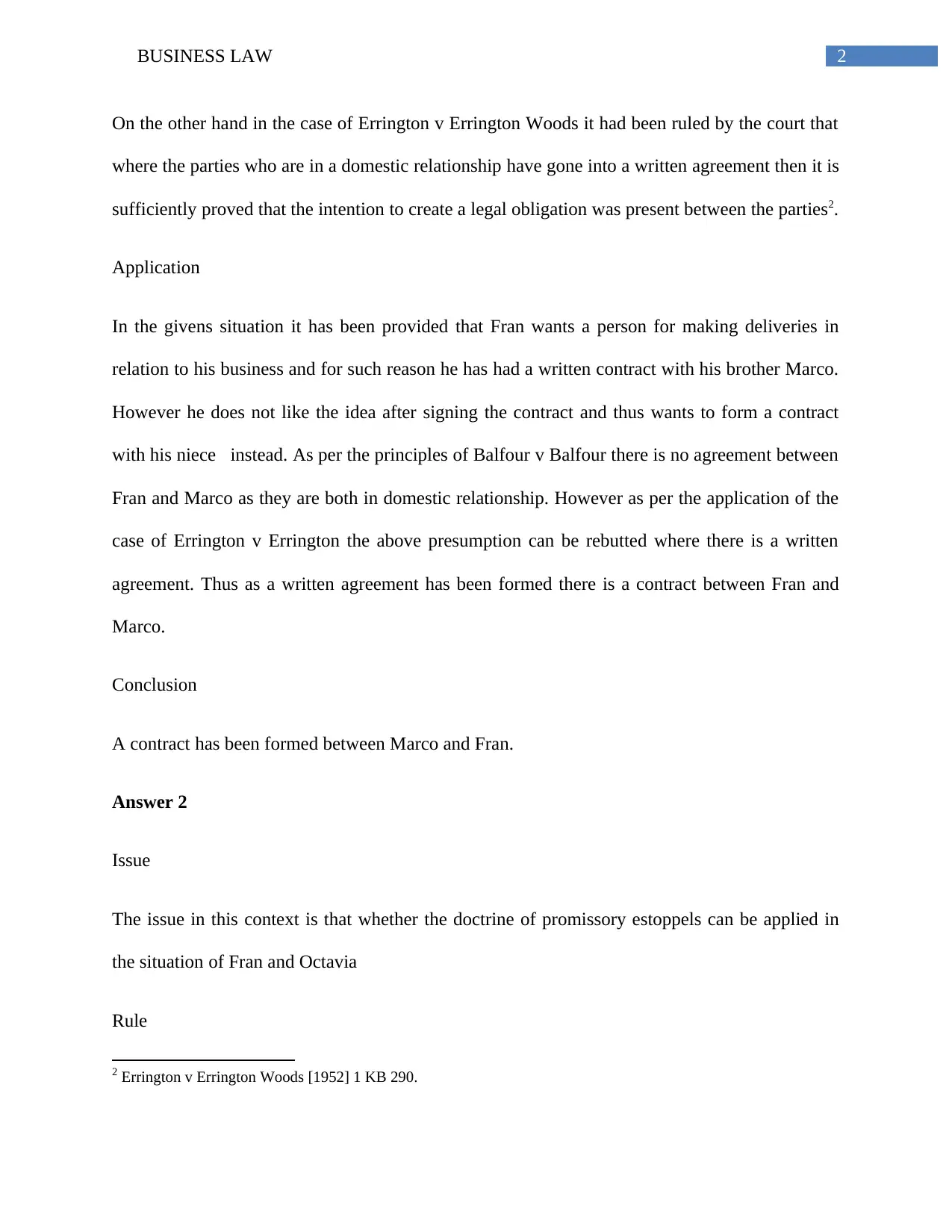
2BUSINESS LAW
On the other hand in the case of Errington v Errington Woods it had been ruled by the court that
where the parties who are in a domestic relationship have gone into a written agreement then it is
sufficiently proved that the intention to create a legal obligation was present between the parties2.
Application
In the givens situation it has been provided that Fran wants a person for making deliveries in
relation to his business and for such reason he has had a written contract with his brother Marco.
However he does not like the idea after signing the contract and thus wants to form a contract
with his niece instead. As per the principles of Balfour v Balfour there is no agreement between
Fran and Marco as they are both in domestic relationship. However as per the application of the
case of Errington v Errington the above presumption can be rebutted where there is a written
agreement. Thus as a written agreement has been formed there is a contract between Fran and
Marco.
Conclusion
A contract has been formed between Marco and Fran.
Answer 2
Issue
The issue in this context is that whether the doctrine of promissory estoppels can be applied in
the situation of Fran and Octavia
Rule
2 Errington v Errington Woods [1952] 1 KB 290.
On the other hand in the case of Errington v Errington Woods it had been ruled by the court that
where the parties who are in a domestic relationship have gone into a written agreement then it is
sufficiently proved that the intention to create a legal obligation was present between the parties2.
Application
In the givens situation it has been provided that Fran wants a person for making deliveries in
relation to his business and for such reason he has had a written contract with his brother Marco.
However he does not like the idea after signing the contract and thus wants to form a contract
with his niece instead. As per the principles of Balfour v Balfour there is no agreement between
Fran and Marco as they are both in domestic relationship. However as per the application of the
case of Errington v Errington the above presumption can be rebutted where there is a written
agreement. Thus as a written agreement has been formed there is a contract between Fran and
Marco.
Conclusion
A contract has been formed between Marco and Fran.
Answer 2
Issue
The issue in this context is that whether the doctrine of promissory estoppels can be applied in
the situation of Fran and Octavia
Rule
2 Errington v Errington Woods [1952] 1 KB 290.
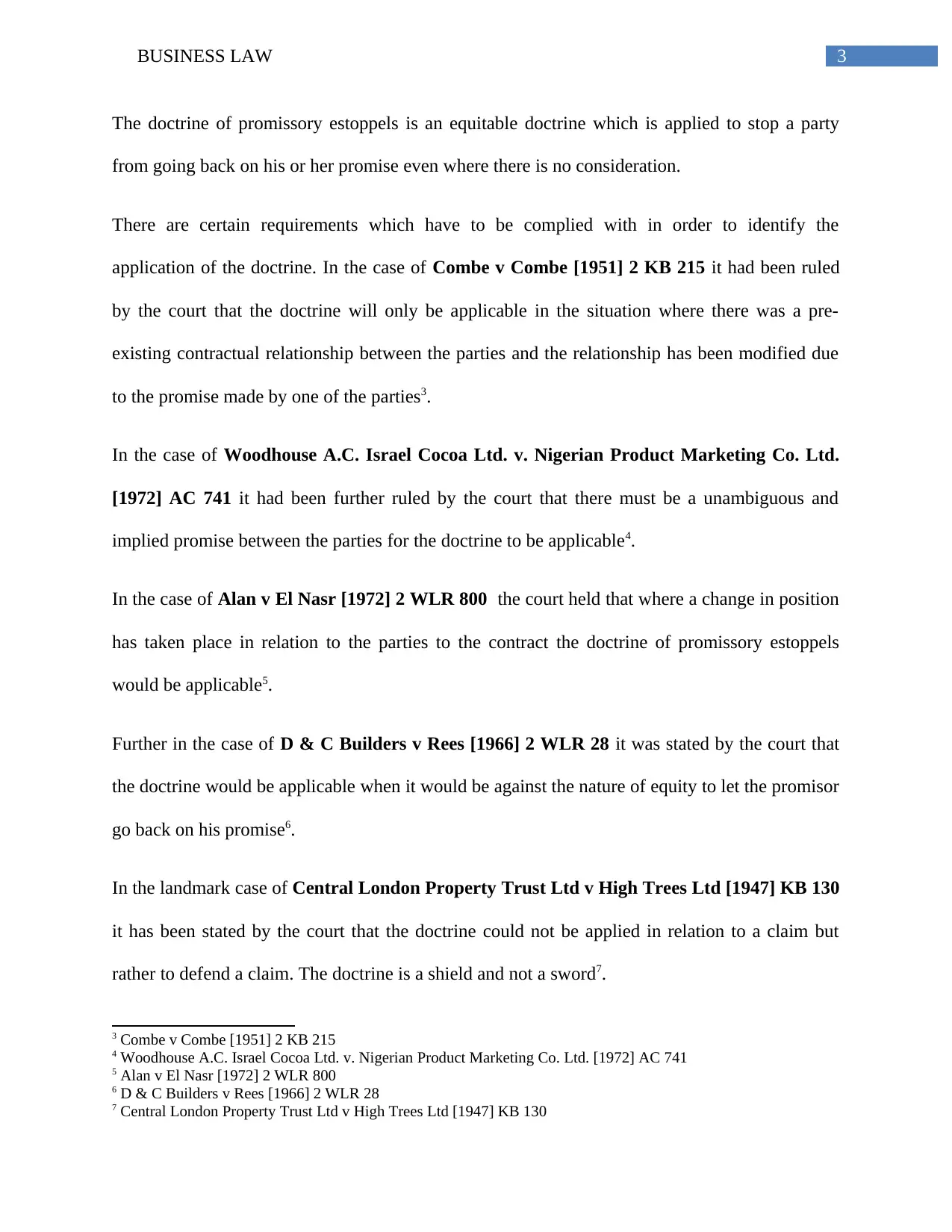
3BUSINESS LAW
The doctrine of promissory estoppels is an equitable doctrine which is applied to stop a party
from going back on his or her promise even where there is no consideration.
There are certain requirements which have to be complied with in order to identify the
application of the doctrine. In the case of Combe v Combe [1951] 2 KB 215 it had been ruled
by the court that the doctrine will only be applicable in the situation where there was a pre-
existing contractual relationship between the parties and the relationship has been modified due
to the promise made by one of the parties3.
In the case of Woodhouse A.C. Israel Cocoa Ltd. v. Nigerian Product Marketing Co. Ltd.
[1972] AC 741 it had been further ruled by the court that there must be a unambiguous and
implied promise between the parties for the doctrine to be applicable4.
In the case of Alan v El Nasr [1972] 2 WLR 800 the court held that where a change in position
has taken place in relation to the parties to the contract the doctrine of promissory estoppels
would be applicable5.
Further in the case of D & C Builders v Rees [1966] 2 WLR 28 it was stated by the court that
the doctrine would be applicable when it would be against the nature of equity to let the promisor
go back on his promise6.
In the landmark case of Central London Property Trust Ltd v High Trees Ltd [1947] KB 130
it has been stated by the court that the doctrine could not be applied in relation to a claim but
rather to defend a claim. The doctrine is a shield and not a sword7.
3 Combe v Combe [1951] 2 KB 215
4 Woodhouse A.C. Israel Cocoa Ltd. v. Nigerian Product Marketing Co. Ltd. [1972] AC 741
5 Alan v El Nasr [1972] 2 WLR 800
6 D & C Builders v Rees [1966] 2 WLR 28
7 Central London Property Trust Ltd v High Trees Ltd [1947] KB 130
The doctrine of promissory estoppels is an equitable doctrine which is applied to stop a party
from going back on his or her promise even where there is no consideration.
There are certain requirements which have to be complied with in order to identify the
application of the doctrine. In the case of Combe v Combe [1951] 2 KB 215 it had been ruled
by the court that the doctrine will only be applicable in the situation where there was a pre-
existing contractual relationship between the parties and the relationship has been modified due
to the promise made by one of the parties3.
In the case of Woodhouse A.C. Israel Cocoa Ltd. v. Nigerian Product Marketing Co. Ltd.
[1972] AC 741 it had been further ruled by the court that there must be a unambiguous and
implied promise between the parties for the doctrine to be applicable4.
In the case of Alan v El Nasr [1972] 2 WLR 800 the court held that where a change in position
has taken place in relation to the parties to the contract the doctrine of promissory estoppels
would be applicable5.
Further in the case of D & C Builders v Rees [1966] 2 WLR 28 it was stated by the court that
the doctrine would be applicable when it would be against the nature of equity to let the promisor
go back on his promise6.
In the landmark case of Central London Property Trust Ltd v High Trees Ltd [1947] KB 130
it has been stated by the court that the doctrine could not be applied in relation to a claim but
rather to defend a claim. The doctrine is a shield and not a sword7.
3 Combe v Combe [1951] 2 KB 215
4 Woodhouse A.C. Israel Cocoa Ltd. v. Nigerian Product Marketing Co. Ltd. [1972] AC 741
5 Alan v El Nasr [1972] 2 WLR 800
6 D & C Builders v Rees [1966] 2 WLR 28
7 Central London Property Trust Ltd v High Trees Ltd [1947] KB 130
Secure Best Marks with AI Grader
Need help grading? Try our AI Grader for instant feedback on your assignments.
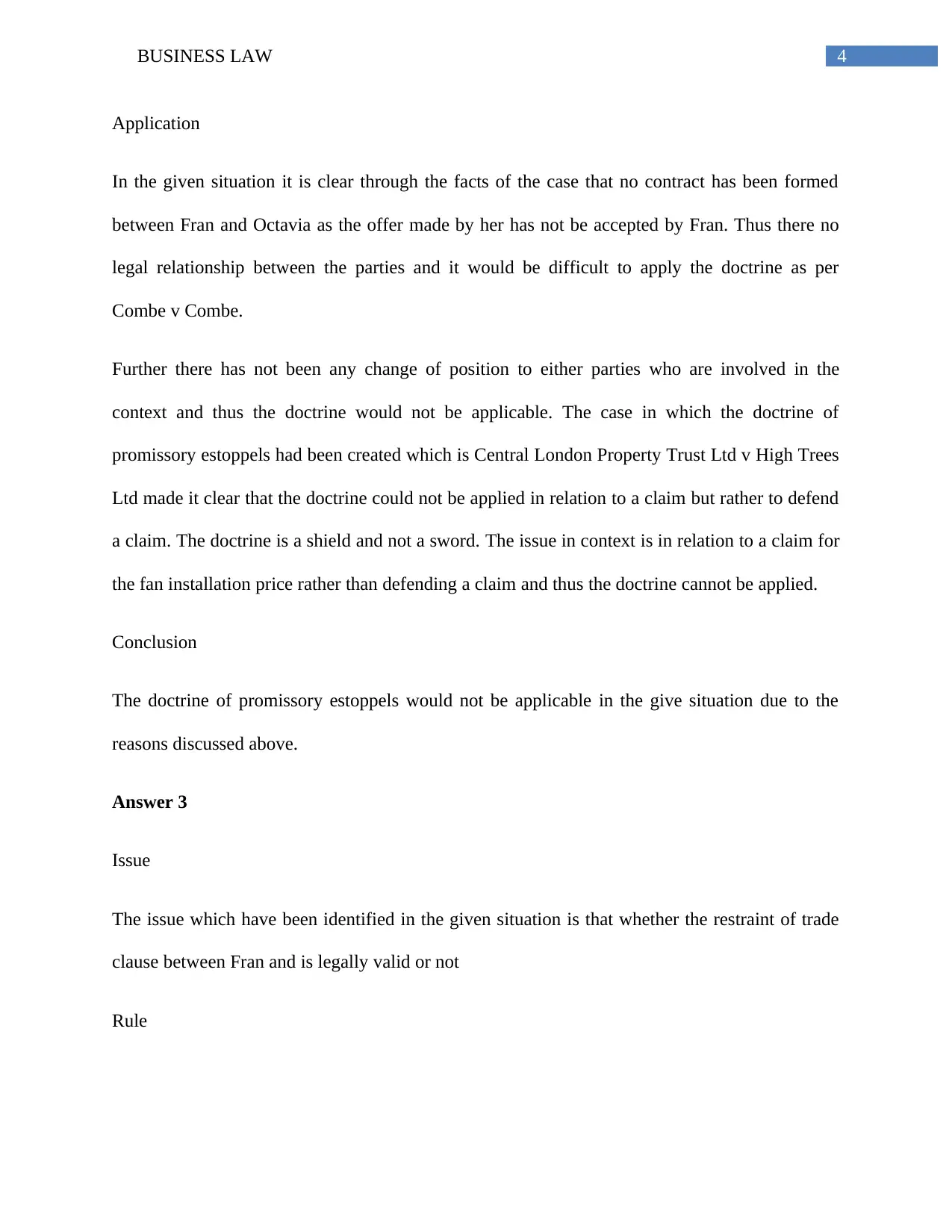
4BUSINESS LAW
Application
In the given situation it is clear through the facts of the case that no contract has been formed
between Fran and Octavia as the offer made by her has not be accepted by Fran. Thus there no
legal relationship between the parties and it would be difficult to apply the doctrine as per
Combe v Combe.
Further there has not been any change of position to either parties who are involved in the
context and thus the doctrine would not be applicable. The case in which the doctrine of
promissory estoppels had been created which is Central London Property Trust Ltd v High Trees
Ltd made it clear that the doctrine could not be applied in relation to a claim but rather to defend
a claim. The doctrine is a shield and not a sword. The issue in context is in relation to a claim for
the fan installation price rather than defending a claim and thus the doctrine cannot be applied.
Conclusion
The doctrine of promissory estoppels would not be applicable in the give situation due to the
reasons discussed above.
Answer 3
Issue
The issue which have been identified in the given situation is that whether the restraint of trade
clause between Fran and is legally valid or not
Rule
Application
In the given situation it is clear through the facts of the case that no contract has been formed
between Fran and Octavia as the offer made by her has not be accepted by Fran. Thus there no
legal relationship between the parties and it would be difficult to apply the doctrine as per
Combe v Combe.
Further there has not been any change of position to either parties who are involved in the
context and thus the doctrine would not be applicable. The case in which the doctrine of
promissory estoppels had been created which is Central London Property Trust Ltd v High Trees
Ltd made it clear that the doctrine could not be applied in relation to a claim but rather to defend
a claim. The doctrine is a shield and not a sword. The issue in context is in relation to a claim for
the fan installation price rather than defending a claim and thus the doctrine cannot be applied.
Conclusion
The doctrine of promissory estoppels would not be applicable in the give situation due to the
reasons discussed above.
Answer 3
Issue
The issue which have been identified in the given situation is that whether the restraint of trade
clause between Fran and is legally valid or not
Rule
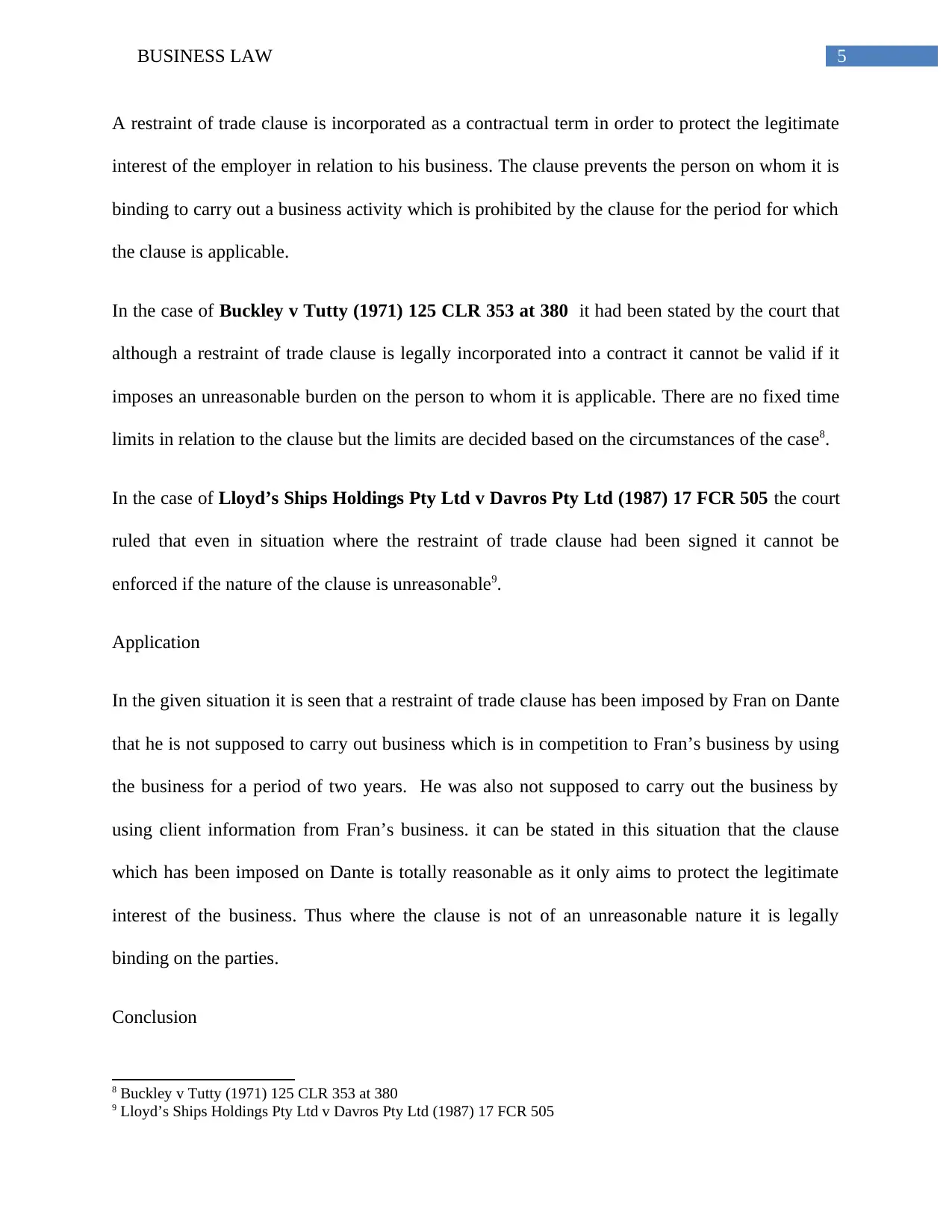
5BUSINESS LAW
A restraint of trade clause is incorporated as a contractual term in order to protect the legitimate
interest of the employer in relation to his business. The clause prevents the person on whom it is
binding to carry out a business activity which is prohibited by the clause for the period for which
the clause is applicable.
In the case of Buckley v Tutty (1971) 125 CLR 353 at 380 it had been stated by the court that
although a restraint of trade clause is legally incorporated into a contract it cannot be valid if it
imposes an unreasonable burden on the person to whom it is applicable. There are no fixed time
limits in relation to the clause but the limits are decided based on the circumstances of the case8.
In the case of Lloyd’s Ships Holdings Pty Ltd v Davros Pty Ltd (1987) 17 FCR 505 the court
ruled that even in situation where the restraint of trade clause had been signed it cannot be
enforced if the nature of the clause is unreasonable9.
Application
In the given situation it is seen that a restraint of trade clause has been imposed by Fran on Dante
that he is not supposed to carry out business which is in competition to Fran’s business by using
the business for a period of two years. He was also not supposed to carry out the business by
using client information from Fran’s business. it can be stated in this situation that the clause
which has been imposed on Dante is totally reasonable as it only aims to protect the legitimate
interest of the business. Thus where the clause is not of an unreasonable nature it is legally
binding on the parties.
Conclusion
8 Buckley v Tutty (1971) 125 CLR 353 at 380
9 Lloyd’s Ships Holdings Pty Ltd v Davros Pty Ltd (1987) 17 FCR 505
A restraint of trade clause is incorporated as a contractual term in order to protect the legitimate
interest of the employer in relation to his business. The clause prevents the person on whom it is
binding to carry out a business activity which is prohibited by the clause for the period for which
the clause is applicable.
In the case of Buckley v Tutty (1971) 125 CLR 353 at 380 it had been stated by the court that
although a restraint of trade clause is legally incorporated into a contract it cannot be valid if it
imposes an unreasonable burden on the person to whom it is applicable. There are no fixed time
limits in relation to the clause but the limits are decided based on the circumstances of the case8.
In the case of Lloyd’s Ships Holdings Pty Ltd v Davros Pty Ltd (1987) 17 FCR 505 the court
ruled that even in situation where the restraint of trade clause had been signed it cannot be
enforced if the nature of the clause is unreasonable9.
Application
In the given situation it is seen that a restraint of trade clause has been imposed by Fran on Dante
that he is not supposed to carry out business which is in competition to Fran’s business by using
the business for a period of two years. He was also not supposed to carry out the business by
using client information from Fran’s business. it can be stated in this situation that the clause
which has been imposed on Dante is totally reasonable as it only aims to protect the legitimate
interest of the business. Thus where the clause is not of an unreasonable nature it is legally
binding on the parties.
Conclusion
8 Buckley v Tutty (1971) 125 CLR 353 at 380
9 Lloyd’s Ships Holdings Pty Ltd v Davros Pty Ltd (1987) 17 FCR 505
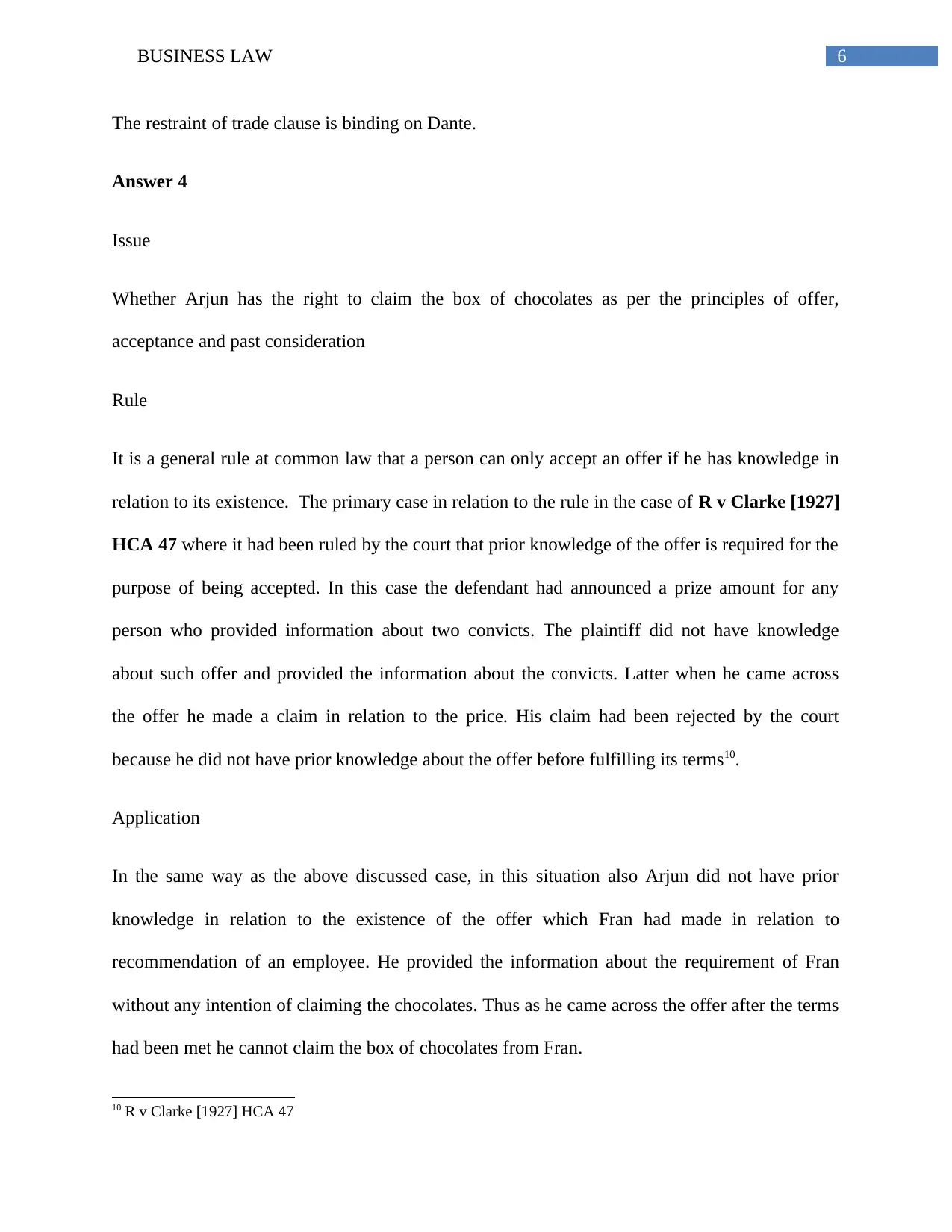
6BUSINESS LAW
The restraint of trade clause is binding on Dante.
Answer 4
Issue
Whether Arjun has the right to claim the box of chocolates as per the principles of offer,
acceptance and past consideration
Rule
It is a general rule at common law that a person can only accept an offer if he has knowledge in
relation to its existence. The primary case in relation to the rule in the case of R v Clarke [1927]
HCA 47 where it had been ruled by the court that prior knowledge of the offer is required for the
purpose of being accepted. In this case the defendant had announced a prize amount for any
person who provided information about two convicts. The plaintiff did not have knowledge
about such offer and provided the information about the convicts. Latter when he came across
the offer he made a claim in relation to the price. His claim had been rejected by the court
because he did not have prior knowledge about the offer before fulfilling its terms10.
Application
In the same way as the above discussed case, in this situation also Arjun did not have prior
knowledge in relation to the existence of the offer which Fran had made in relation to
recommendation of an employee. He provided the information about the requirement of Fran
without any intention of claiming the chocolates. Thus as he came across the offer after the terms
had been met he cannot claim the box of chocolates from Fran.
10 R v Clarke [1927] HCA 47
The restraint of trade clause is binding on Dante.
Answer 4
Issue
Whether Arjun has the right to claim the box of chocolates as per the principles of offer,
acceptance and past consideration
Rule
It is a general rule at common law that a person can only accept an offer if he has knowledge in
relation to its existence. The primary case in relation to the rule in the case of R v Clarke [1927]
HCA 47 where it had been ruled by the court that prior knowledge of the offer is required for the
purpose of being accepted. In this case the defendant had announced a prize amount for any
person who provided information about two convicts. The plaintiff did not have knowledge
about such offer and provided the information about the convicts. Latter when he came across
the offer he made a claim in relation to the price. His claim had been rejected by the court
because he did not have prior knowledge about the offer before fulfilling its terms10.
Application
In the same way as the above discussed case, in this situation also Arjun did not have prior
knowledge in relation to the existence of the offer which Fran had made in relation to
recommendation of an employee. He provided the information about the requirement of Fran
without any intention of claiming the chocolates. Thus as he came across the offer after the terms
had been met he cannot claim the box of chocolates from Fran.
10 R v Clarke [1927] HCA 47
Paraphrase This Document
Need a fresh take? Get an instant paraphrase of this document with our AI Paraphraser
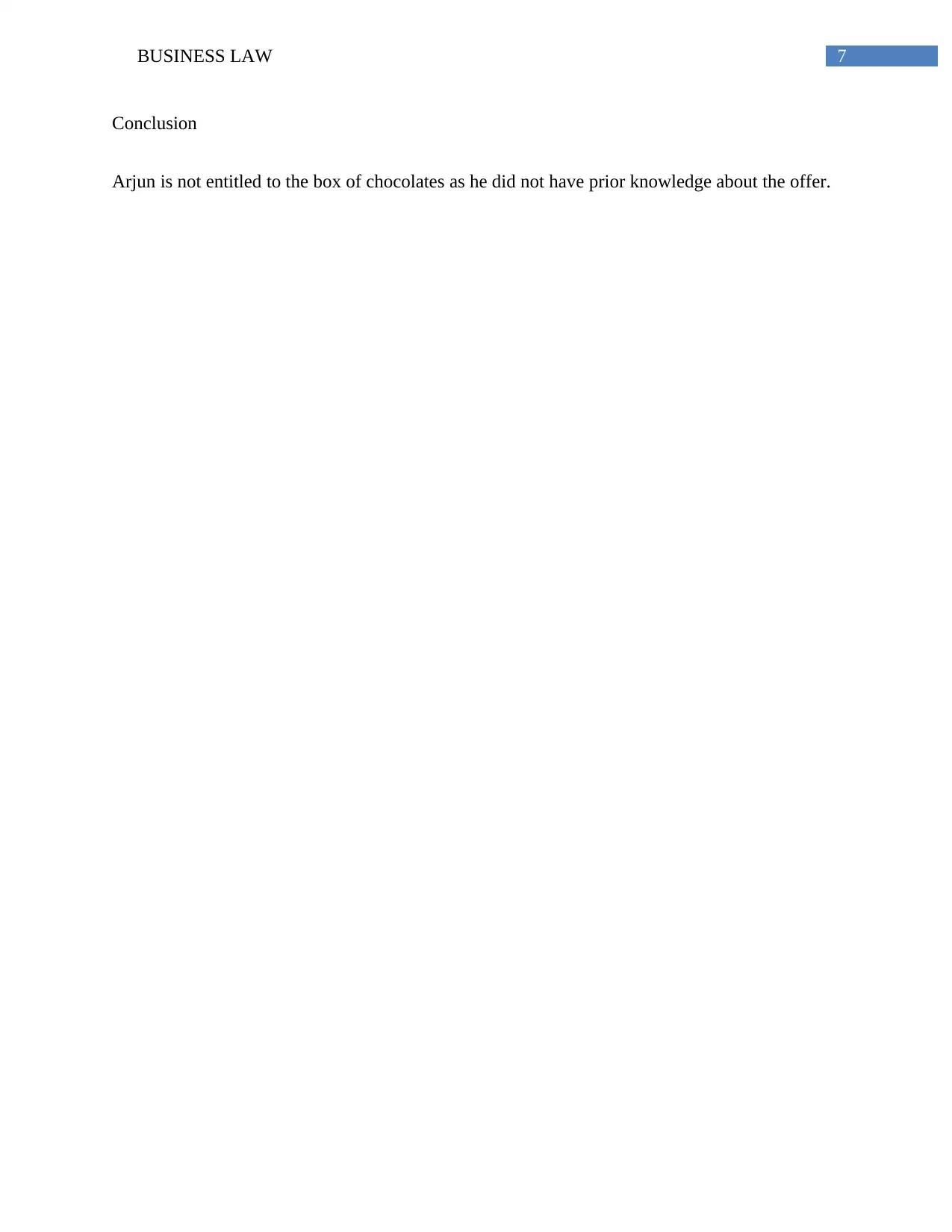
7BUSINESS LAW
Conclusion
Arjun is not entitled to the box of chocolates as he did not have prior knowledge about the offer.
Conclusion
Arjun is not entitled to the box of chocolates as he did not have prior knowledge about the offer.
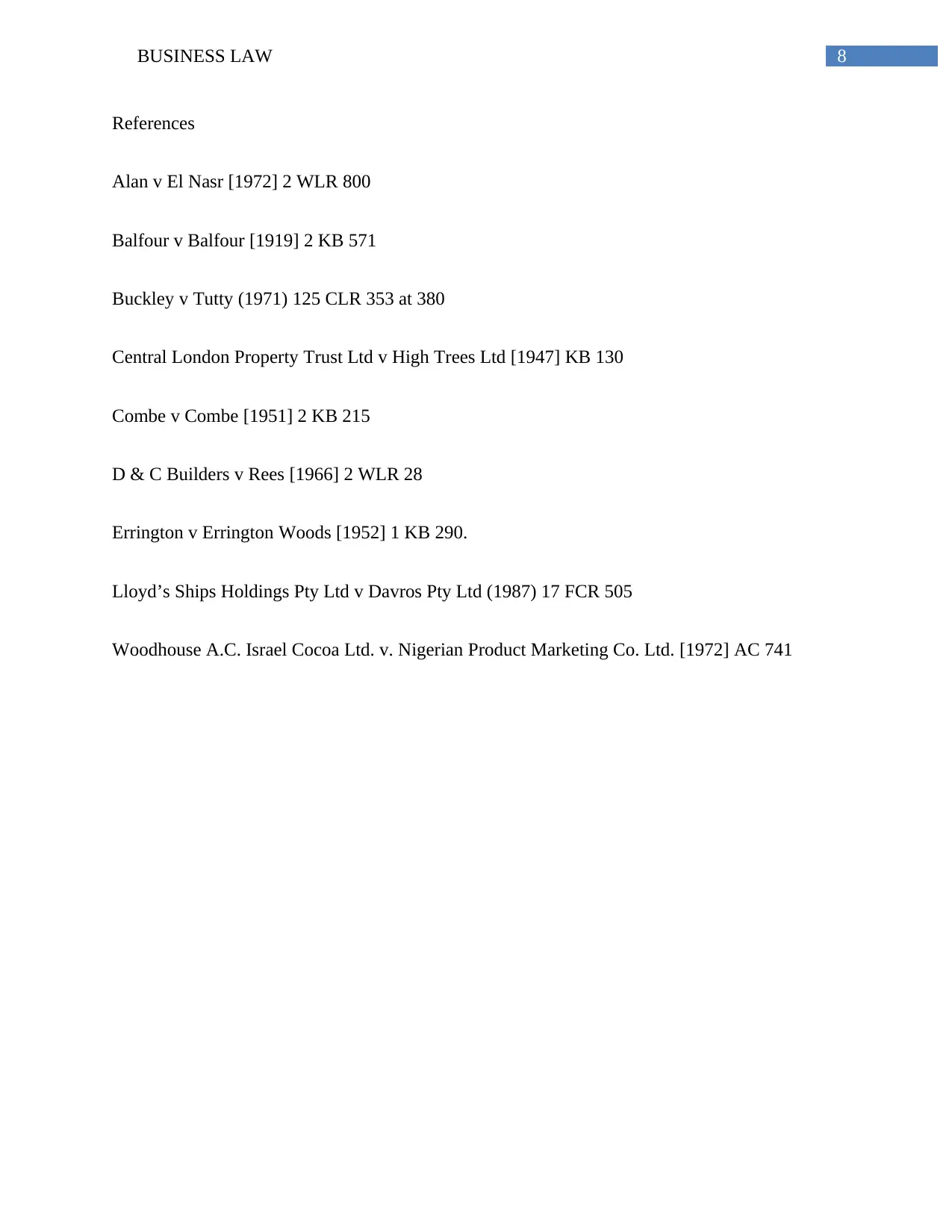
8BUSINESS LAW
References
Alan v El Nasr [1972] 2 WLR 800
Balfour v Balfour [1919] 2 KB 571
Buckley v Tutty (1971) 125 CLR 353 at 380
Central London Property Trust Ltd v High Trees Ltd [1947] KB 130
Combe v Combe [1951] 2 KB 215
D & C Builders v Rees [1966] 2 WLR 28
Errington v Errington Woods [1952] 1 KB 290.
Lloyd’s Ships Holdings Pty Ltd v Davros Pty Ltd (1987) 17 FCR 505
Woodhouse A.C. Israel Cocoa Ltd. v. Nigerian Product Marketing Co. Ltd. [1972] AC 741
References
Alan v El Nasr [1972] 2 WLR 800
Balfour v Balfour [1919] 2 KB 571
Buckley v Tutty (1971) 125 CLR 353 at 380
Central London Property Trust Ltd v High Trees Ltd [1947] KB 130
Combe v Combe [1951] 2 KB 215
D & C Builders v Rees [1966] 2 WLR 28
Errington v Errington Woods [1952] 1 KB 290.
Lloyd’s Ships Holdings Pty Ltd v Davros Pty Ltd (1987) 17 FCR 505
Woodhouse A.C. Israel Cocoa Ltd. v. Nigerian Product Marketing Co. Ltd. [1972] AC 741
1 out of 9
Related Documents
Your All-in-One AI-Powered Toolkit for Academic Success.
+13062052269
info@desklib.com
Available 24*7 on WhatsApp / Email
![[object Object]](/_next/static/media/star-bottom.7253800d.svg)
Unlock your academic potential
© 2024 | Zucol Services PVT LTD | All rights reserved.


